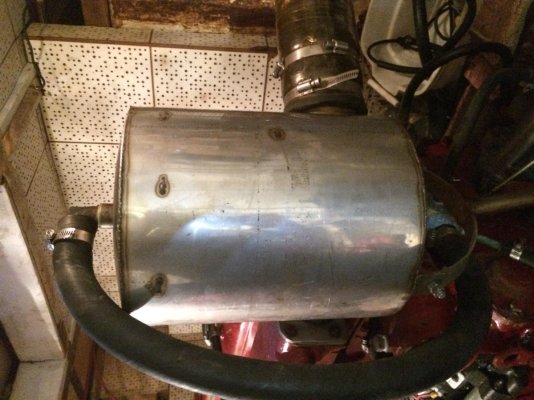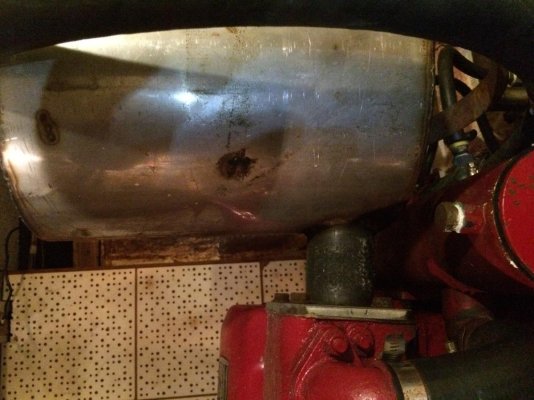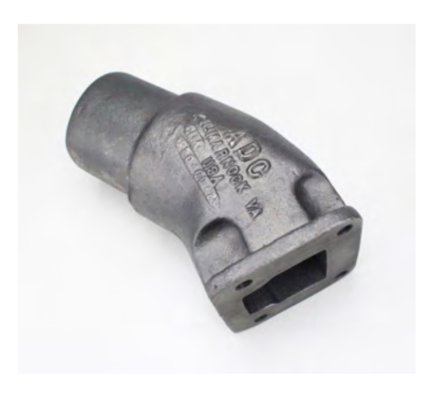tdcody
Member
- Joined
- Sep 26, 2014
- Messages
- 8
- Location
- USA
- Vessel Name
- Sea Sun
- Vessel Make
- 1978 Universal Litton 41 Europa
Hi all,
After a few years of finding all the info I needed by searching this forum in hundreds of situations, I can't seem to find anything this time.
1978 Universal Litton Europa 41 with twin Lehman 120s, new to me a little less than 3 years ago.
I have these unusual (I think) stainless exhaust mufflers/mixers which look custom made. On the prepurchase engine survey, I was told these "umbrella type" mufflers were prone to internal corrosion failure which could allow raw water back into the engine. He recommended replacing with a waterlift style. A mechanic that I followed up with about muffler replacement suggested I wait until they started visibly corroding and/or leaking before replacing.
Both mufflers are now leaking raw water from welded seams at their bottom. They still run cool aside from making a mess. I am looking for info about them to help decide whether they should be rebuilt by a metal shop (?) or replaced with something else.
Photos (apologies for orientation- I can't get iOS photos to orient correctly when uploading): view forward from the aft end of one muffler showing raw water hose into the top of the muffler and wet exhaust hose exiting the side, and side view of same muffler showing the straight pipe exiting the engine welded to the exhaust can.
Not sure if it matters, but other things I found unusual (I think) are that the exhaust hoses seem big (5" OD) and they exit mostly below the waterline, so while I know the appropriate exhaust sound at startup and feel for overheating of the mufflers, I can't actually see the water flow.
Any info about what these are, what I should be thinking about when repairing or replacing, and (if repairing is an option) where I might get that done would be much appreciated. Thank you!!!
Dave Geiger
After a few years of finding all the info I needed by searching this forum in hundreds of situations, I can't seem to find anything this time.
1978 Universal Litton Europa 41 with twin Lehman 120s, new to me a little less than 3 years ago.
I have these unusual (I think) stainless exhaust mufflers/mixers which look custom made. On the prepurchase engine survey, I was told these "umbrella type" mufflers were prone to internal corrosion failure which could allow raw water back into the engine. He recommended replacing with a waterlift style. A mechanic that I followed up with about muffler replacement suggested I wait until they started visibly corroding and/or leaking before replacing.
Both mufflers are now leaking raw water from welded seams at their bottom. They still run cool aside from making a mess. I am looking for info about them to help decide whether they should be rebuilt by a metal shop (?) or replaced with something else.
Photos (apologies for orientation- I can't get iOS photos to orient correctly when uploading): view forward from the aft end of one muffler showing raw water hose into the top of the muffler and wet exhaust hose exiting the side, and side view of same muffler showing the straight pipe exiting the engine welded to the exhaust can.
Not sure if it matters, but other things I found unusual (I think) are that the exhaust hoses seem big (5" OD) and they exit mostly below the waterline, so while I know the appropriate exhaust sound at startup and feel for overheating of the mufflers, I can't actually see the water flow.
Any info about what these are, what I should be thinking about when repairing or replacing, and (if repairing is an option) where I might get that done would be much appreciated. Thank you!!!
Dave Geiger




